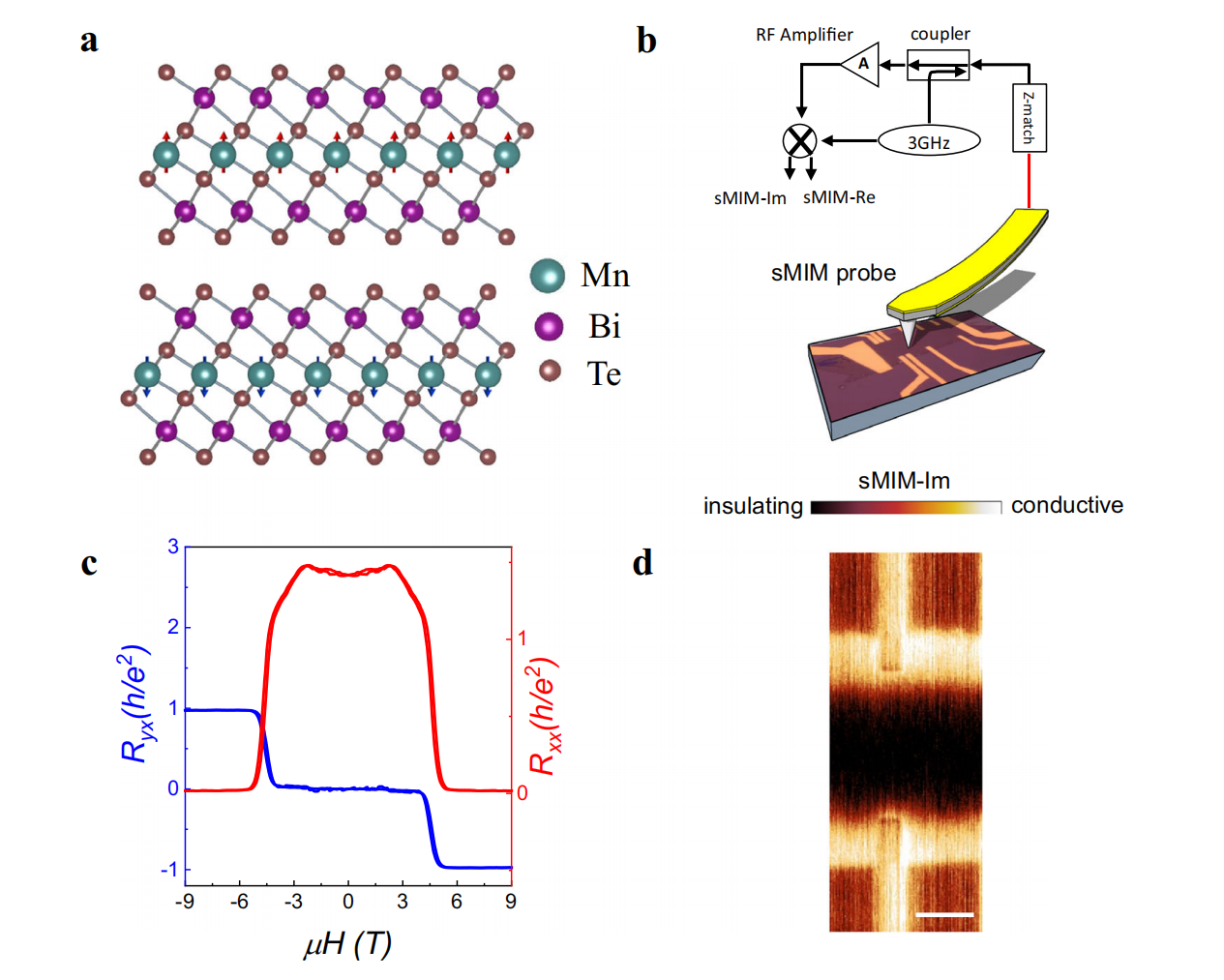Direct visualization of edge state in even-layer MnBi2Te4 at zero magnetic field
Weiyan Lin, Yang Feng, Yongchao Wang, Jinjiang Zhu, Zichen Lian, Huanyu Zhang, Hao Li, Yang Wu, Chang Liu, Yihua Wang, Jinsong Zhang, Yayu Wang, Chui-Zhen Chen, Xiaodong Zhou & Jian Shen
Abstract
Being the first intrinsic antiferromagnetic (AFM) topological insulator (TI), MnBi2Te4 is argued to be a topological axion state in its even-layer form due to the antiparallel magnetization between the top and bottom layers. Here we combine both transport and scanning microwave impedance microscopy (sMIM) to investigate such axion state in atomically thin MnBi2Te4 with even-layer thickness at zero magnetic field. While transport measurements show a zero Hall plateau signaturing the axion state, sMIM uncovers an unexpected edge state raising questions regarding the nature of the “axion state”. Based on our model calculation, we propose that the edge state of even-layer MnBi2Te4 at zero field is derived from gapped helical edge states of the quantum spin Hall effect with time-reversal-symmetry breaking, when a crossover from a three-dimensional TI MnBi2Te4 to a two-dimensional TI occurs. Our finding thus signifies the richness of topological phases in MnB2Te4 that has yet to be fully explored.
Summary of the paper
This study combines transport measurements and scanning microwave impedance microscopy (SMM) to investigate the topological states of even-layer (6-septuple-layer, 6-SL) MnBi2Te4 — the first intrinsic antiferromagnetic (AFM) topological insulator (TI) — at zero magnetic field.
Key findings include:
Transport measurements reveal a zero Hall plateau (ZHP), previously hypothesized to indicate an axion insulator state. However, SMM imaging uncovers an unexpected conductive edge state at zero field, contradicting the insulating edge requirement of an axion insulator.
At high magnetic fields (>6 T), SMM confirms a Chern insulator phase: an insulating bulk enclosed by a conductive chiral edge state, consistent with transport observations of quantized Hall resistance.
Model calculations suggest even-layer MnBi2Te4 at zero field is not an axion state but a time-reversal-symmetry (TRS)-breaking quantum spin Hall (QSH) phase, hosting gapped helical edge states (due to AFM order-induced TRS breaking).
This work revises the understanding of topological phases in MnBi2Te4, highlighting its unexploited phase richness and the value of SMM for spatially resolving topological edge states.

在本篇文章中,扫描微波阻抗显微镜SMM具体的应用场景和作用如下:
- 表征不同拓扑相的边缘态:在高磁场(如 9T)的陈绝缘体相,SMM 成像显示样品内部绝缘(信号低于 SiO₂衬底)、边缘呈高导电亮线,符合陈绝缘体 “绝缘体块 + 手性导电边缘” 特征;零磁场零霍尔平台(ZHP)相,SMM 观测到持续的导电边缘态,与轴子绝缘体 “绝缘边缘” 的预期矛盾,为质疑ZHP相的轴子态本质提供关键依据。
- 追踪磁场驱动的拓扑相变:通过 SMM 观测不同磁场区间的电导率分布,清晰划分三阶段:低场(0-4T,ZHP 相)保持体 - 边对比度,证实边缘态稳定;中场(4-5T,相变区)体相先金属化再绝缘化,反映体带隙闭合与重开;高场(6-9T,陈绝缘体相)恢复 “绝缘体块 + 导电边缘”,且SMM体信号与输运测量的体电流场依赖性定性一致,共同验证相变中的体金属 - 绝缘体转变。
- 分析边缘态特性并排除非拓扑机制:SMM观测到约2μm的边缘态宽度(远大于其<100nm空间分辨率),结合理论归因于体系无序导致的体 - 边散射增强与交换能隙抑制;且在两个独立 6-SL MnBi₂Te₄器件中均观测到导电边缘态,排除边缘污染、局部体无序等平庸边缘态可能,支撑边缘传导的拓扑起源。



